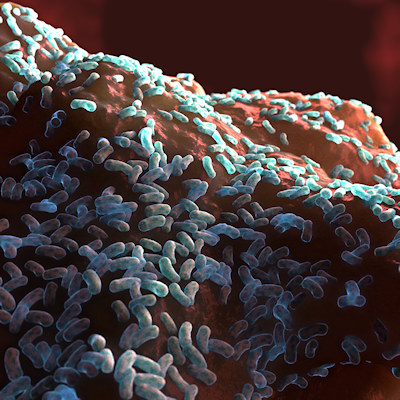July 28, 2022 -- Researchers have found a lipid in the cell membrane of Akkermansia muciniphila that is responsible for the effect of a gut-resident bacterium on immune processes, with the potential to develop drugs that fight disease by piggybacking on the molecular mechanism.
Harvard Medical School and Broad Institute researchers showed the lipid communicates with two receptors found on the surface of many immune cells, namely toll-like receptor 1 and 2 (TLR1 and TLR2). Activation of the receptors by the fat triggered the release of certain cytokines, immune proteins that play a role in inflammation. The researchers also showed the lipid helps maintain immune homeostasis.
The study, details of which were published July 27 in Nature, marks an advance in work to understand how the gut microbiome affects host physiology. There was already extensive evidence of links between bacteria including A. muciniphila and human processes such as metabolism and immunity, but there was a lack of knowledge of the mechanisms that drive the effects.
"The real significance of this work was connecting a bacterium, the molecule it makes, the pathway it operates through, and the biological outcome. That's very rare," Jon Clardy, PhD, co-senior author of the study and Hsien Wu and Daisy Yen Wu Professor of Biological Chemistry and Molecular Pharmacology in the Blavatnik Institute at Harvard Medical School, said in a statement.
To identify and understand the lipid, Clardy and his collaborators relied on traditional methods, rather than the genomic and metabolomic analyses that are at the cutting edge of microbiome studies. Specifically, the team used spectroscopic analysis and chemical synthesis, techniques better suited than more modern approaches to the task of identifying the lipid and its generic structure.
The researchers looked at the ability of A. muciniphila cultures to induce cytokine release, leading them to zero in on a single active lipid fraction that produced robust tumor necrosis factor A induction. Mass spectroscopic analysis revealed the molecular formula, pointing to the presence of a phospholipid, and nuclear magnetic resonance analysis identified a phosphatidylethanolamine (PE). PE is the dominant membrane phospholipid in most bacteria.
After uncovering the structure of the lipid, the researchers sought to show how it interacts with the immune system. The work revealed that the lipid helps maintain immune homeostasis. Low doses of the lipid stop the immune system from reacting to potentially harmful molecules until they reach significant levels.
The study points to drug development opportunities. By describing the molecular mechanism of a druggable pathway, the researchers have suggested ways to piggyback on the bacterium's ability to modulate the immune system to treat disease. The work also provides a blueprint for how to study the interactions between other bacteria and host physiology.
At the same time, the authors of the study noted that "the data underlying the model are from in vitro studies and in vivo studies will be needed to fully validate it."
Copyright © 2022 scienceboard.net








